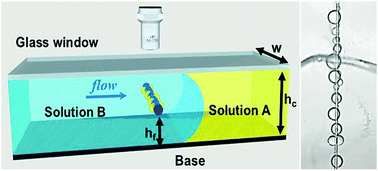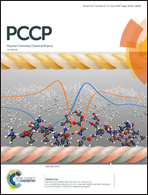Growth of nanodroplets on a still microfiber under flow conditions†
Abstract
Surface droplets in the microscale are of great interest for their relevance in broad droplet-based technologies. Derived from the Ouzo effect, the solvent exchange process is a simple bottom-up approach to produce surface nano-/micro-droplets by the nucleation and growth mechanism. The oil oversaturation pulse is created as a good solvent (ethanol) for the oil displaced by a poor solvent (water) in the flow cell. In this work, we investigated the formation of surface droplets on a one-dimensional substrate (a single hydrophobic fiber with a diameter of 10 μm) in a flow. The droplet growth on the microfiber is enhanced as the fiber is perpendicular to the external flow direction, due to the coupled effects between the droplet formation and the local flow. On the other hand, the droplet growth exhibits different growth dynamics when the fiber is placed parallel to the external flow direction. The general trend that surface droplets grow faster on a fiber at higher flow rates is consistent with the situation on planar substrates. The coupled interactions between the growing droplets and the local flow conditions during the solvent exchange process were further revealed in the simulations. The findings from this work will be valuable for the design and utilization of the solvent exchange process to produce surface nanodroplets on a microfiber under flow conditions and thus broaden the droplet-based application fields.

- This article is part of the themed collection: 2018 PCCP HOT Articles


 Please wait while we load your content...
Please wait while we load your content...